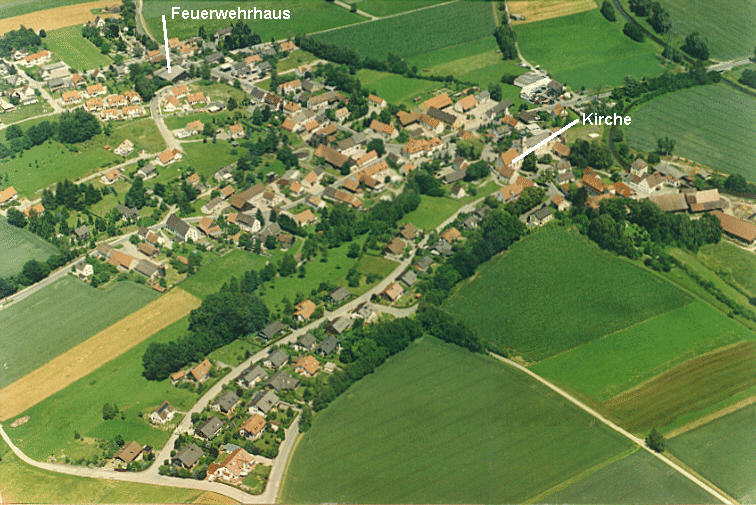Batzenhofen
in the course of time
Batzenhofen (Bavaria,
Germany) is situated at the left bank of the river Schmutter near the eastern
foothills of the so called üRauher Forstü (i.e. desolate forest), which
belongs to the nature park Augsburg western forests. The hilly area of
the rural commune shows heights between 449 and 520 meters above sea level.
The municipality can look back on a long and eventful history. At the Katharinaberg
more than 500 regularly dug pits were found, which experts dated to the
time of the Celts about 500 BC. The origin of the village happened probably
around 800, when many places ending with ü...hofenü were founded. The early
name Pazcinhova is interpreted as üHof des Bazzoü (i.e. farm of Bazzo with
Bazzo = fighter), but may also be a connection of the latin üpascuaü (=
pasture) and the alemannian ühofa, hufa, hubaü (= farmstead).
The name Pazcinhova
already in the 13th Century had developed to üBazenhovenü as a forerunner
of the today's name Batzenhofen. Until 838 Batzenhofen belonged to the
convent of Kempten and 969 parts of Batzenhofen were given to the monastery
St. Stephan, which was founded by bishop Ulrich in that time. Because of
this deed of donation the village could celebrate it's 1000 year anniversary
already in 1969.

Bishop Ulrich of Augsburg recorded
in 969 the foundation of the Kanonissen convent St. Stephan.
The document shows a reference to
Batzenhofen ("Pazenhoua").
The monastery of St.
Stephan built a castle, that was used as summer residence and recreation
place by the ladies of the convent. Later were added a brewery and a tavern.
In 1925 the whole complex was sold to the Innere Mission" and since then
used as old people's home "Sonnenhof". Gradually the whole village came
into possession of the convent, which ruled up to the secularization in
1803. From this time, when her Grace, the high aristocrat Abbess of
the Realm-free ladies Convent St. Stephan of Augsburg was sovereign
over Batzenhofen, the following directive is delivered to us: "With
true pain and to our highest displeasure we had get to know the fact, that
the peasants of our rule Batzenhofen in their perverseness go so far, not
only to shave themselves but sometimes even shave one another. Why in our
motherly solicitude we did set up an examined and well experienced barber
in each of our villages? Therefore we order a new, that from now on everyone
of our subjects proceeds at least once a week to his by high authority
set up barber and neither shaves himself nor let scrape off his beard by
someone else.quot;

View of Batzenhofen with brewery and
parish church. Copperplate engraving by Thomas Weber from the year 1795.
The oldest list of
properties of St. Stephan mentions in the year 1401 seven estates in Batzenhofen,
four farms and three mercenary houses. In 1492, when Columbus sailed to
America, Batzenhofen already had 22 buildings with fireplace inside. "Bet
Kind bet, morgen kommt der Schwed'" (i.e. pray child pray, tomorrow comes
the Swede), this call also echoed through the peaceful village in the Schmutter
valley. In the Thirty Years' War many houses were destroyed and half of
the inhabitants died. In 1738 there were 47 houses. This number remained
almost unchanged for more than hundred years. The Napoleon Wars 1805 to
1815, the wars of 1866 and 1870/71 and the two World Wars demanded their
tributes, the latter also between the civilian population again. Older
people of Batzenhofen still remember 27th February 1945, when World War
II brought death and destruction to the middle of the village: A bomb hit
the schoolyard and tore teacher Pesta together with his wife and Ms Hummel
out of life. A fresco at the right side of the choir in the parish church
St. Martin reminds of this bad day. The current parish church was rebuilt
in the years 1719 and 1720, using the structural fabric of a house of worship
existing since 1500: Parts of the gothic choir and the steeple were integrated
into the new building. The parsonage, built in 1705, is one of the oldest
in the district. In 1766 the chapel dedicated to St. Sebastian was built.
Believing the legend, the chapel should be built at the highest point of
the village, the former Thing place with the mighty old oak. But night
after night the building material as if by magic moved down to the place
where you can find the chapel today. But the name "Kirchberg" (= church
hill) remained until today for that place and confuses visitors of
the village. The school, built in 1908, was given up 1969 because of the
school reform and pulled down later. In the year 1912 the modern trend
came to Batzenhofen, when the village got it's connection to electrical
power. For electrical lightning Batzenhofen had to wait until 1954 however.
In 1958 main street was tarred and parts of the town got a sewage system.
1966 the private wells could be closed, when the central water supply plant
was put into operation. It should last additional 10 years to solve the
question of waste water by a new sewage system. In 1975 a community hall
with fire station was built. Three years later the history of Batzenhofen
as an independent municipality ended and the village got incorporated to
the city of Gersthofen. This caused the classification of further construction
sites. The center of the village got closed by the development of both
Katharinaberg and Kirchberg. The central position of Batzenhofen between
the western parts of town Edenbergen, Hirblingen and Rettenbergen made
it possible to built a parish hall with kindergarten, that is used since
1994.
It can be assumed that
the calm village because of it's location close to Augsburg will prosper
successfully in the shade of Gersthofen without losing it's own character.
Franz X. Köhler

Bird's-eye view of Batzenhofen
|

